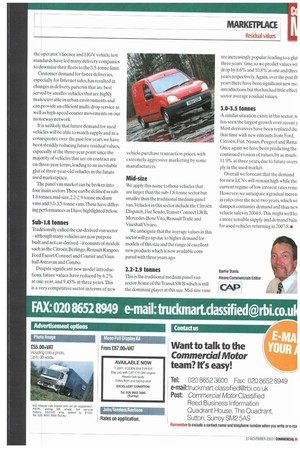Have YOU seen the lights?
Page 70

Page 71

If you've noticed an error in this article please click here to report it so we can fix it.
Light CV registrations are set to end the year 13% ahead of the 2002 total. A lot of this growth has come from the large panel van sector, which is growing steadily.
There are several reasons for the growth in van sales.The country's economy has continued to grow with consumer spending encouraged by low interest rates fuelling high levels of re-mortgaging and forever increasing levels of personal debt. This has led to an increase in the volume of goods being bought and greater demand for vehicles to deliver them.
Another major contributory factor involves the contract hire sector. Many organisations have already set up, or are considering setting up, dedicated LCV operations — a trend which is resulting in large increases in new vehicle sales as they tempt operators out of older models with attractive rental options.
The last significant reason for increased demand revolves around vehicle and driver legislation. The requirement for new drivers to pass an HGV test for vehicles over 33 tonnes, the shortage of such qualified drivers and the added complications of the perator's licence and HGV vehicle test staidards have led many delivery companies to downsize their fleets to the 3.5-tonne limit.
Cstomer demand for faster deliveries, espcially for Internet sales, has resulted in changes in delivery patterns that are best served by smaller vehicles that are highly manoeuvrable in urban environments and can provide an efficient multi-drop service as well as high-speed courier movements on our motorway network.
It is unlikely that future demand for used vehicles will be able to match supply and as a consequence over the past few years we have been steadily reducing future residual values, especially at the three-year point since the majority of vehicles that are on contract are on three-year terms, leading to an inevitable glut of three-year-old vehicles in the future used marketplace.
The panel van market can be broken into four main sectors.These can be defined as sub1.8 tonnes,mid-size,2.2-2.9-tonne medium vans and 3.0-3.5-tonne vanslhese have differing performances as I have highlighted below.
Sub-1.8 tonnes
Traditionally called the car-derived van sector — although many vehicles are now purpose built and not car-derived— it consists of models such as the CitrotriBerlingo, Renault Kangoo, Ford Escort/Connect and Courier and Vauxhall Astravan and Combo.
Despite significant new model introductions, future values have reduced by 6.2% at one year, and 9.45% at three years.This is a very competitive sector in terms of new vehicle purchase transaction prices, with extremely aggressive marketing by some manufacturers.
Mid-size
We apply this name to those vehicles that are larger than the sub-1.8-tonne sector but smaller than the traditional medium panel van.Vehicles in this sector include the Citroen Dispatch, Fiat Scudo,Transit Connect LWB, Mercedes-Benz Vito, Renault Trafic and Vauxhall Vivaro.
We anticipate that the average values in this sector will go up due to higher demand for models of this size and the range of excellent new products which is now available compared with three years ago.
2.2-2.9 tonnes
This is the traditional medium panel van sector, home of theTransit SWB which is still the dominant player at this size. Mid-size vans are increasingly popular, leading to a glui three years' time, so we predict values wil drop by 8.6% and 10.8% at one and thret years respectively. Again, over the past th years there have been significant new mc introductions but this has had little effect sector average residual values.
3.0-3.5 tonnes
A similar situation exists in this sector, w has seen the largest growth over recent ) Most derivatives have been replaced dui that time with new entrants from Ford, Citroen,Fiat, Nissan, Peugeot and Rena Once again we have been predicting the continued erosion of values, by as much ; 11.9% at three years, due to future overs ply in the used market.
Overall we forecast that the demand for new LCVs will remain high while the current regime of low interest rates reme However, we anticipate a gradual increa: in rates over the next two years, which wi dampen consumer demand and thus nev vehicle sales in 2004/5.This might well le; a more sensible supply and demand bala for used vehicles returning in 2007/8.


























































































































































































